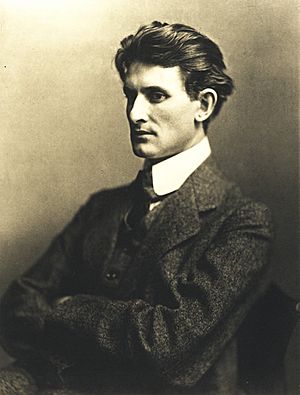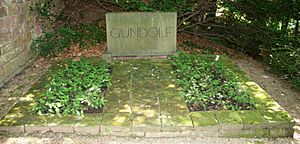Friedrich Gundolf facts for kids
Friedrich Gundolf, whose birth name was Friedrich Leopold Gundelfinger, was born on June 20, 1880. He was a German-Jewish literary scholar and poet. Gundolf became one of the most famous academics during the Weimar Republic, a period in German history. He passed away on July 12, 1931.
Contents
Early Life and Studies
Friedrich Gundolf's father was a mathematician. Friedrich studied art history, German language, and literature. He attended universities in Munich, Berlin, and Heidelberg. In 1903, he earned his doctorate degree. Eight years later, he achieved the status of a professor. This was a big step in his academic career.
His important work, Shakespeare und der deutsche Geist (Shakespeare and the German Spirit), was published in 1911. This book changed how German language and literature were studied.
Joining the George Circle
Gundolf became an important member of the Georgekreis in 1899. This was a group of artists and thinkers led by the poet Stefan George. Gundolf first published his poems in George's magazine, the Blätter für die Kunst.
From 1910 to 1911, Gundolf edited the Jahrbuch für die geistige Bewegung (Yearbook for the Spiritual Movement). This yearbook shared the cultural and political ideas of the Georgekreis. Gundolf and Stefan George were good friends for more than twenty years. However, George later ended their friendship when Gundolf got married in 1926.
His Ideas on Literature
In his studies of literature, Gundolf brought a new way of thinking. He looked at literature from a historical point of view. He focused on understanding the poet's ideas and philosophy.
For Gundolf, great writers like William Shakespeare and Johann Wolfgang von Goethe were symbols of their time. In his research, he wanted to show not only the artists themselves but also how their works influenced people.
Professor at Heidelberg University
From 1916 until the late 1920s, Friedrich Gundolf was a professor at Heidelberg University. One of his students in 1921 was Joseph Goebbels. Goebbels later became a propaganda minister for the Nazis. At that time, Goebbels admired Gundolf and his colleague Max Freiherr von Waldberg. Gundolf also became friends with Arthur Salz, an economist and fellow professor at Heidelberg.
Death and Lasting Impact
In 1927, doctors found that Gundolf had cancer. He died from the illness four years later. After his death, in 1933, the Nazis banned Gundolf's works.
Gundolf was married to Agathe Mallachow, who was a pianist. Their daughter, Cordelia Gundolf, became a professor of Italian language and literature. She was also the godchild of artist Melchior Lechter. After her father died and Adolf Hitler came to power in Germany, Cordelia's mother asked Albert Einstein for advice. This led the family to move to Capri and then to Rome to escape the Nazis.
Famous Works
Gundolf's most famous book is Goethe, published in 1916. This book was very popular and had 13 editions by 1930. In it, he further developed his ideas about understanding important figures in literature.
In 1964, the Deutsche Akademie für Sprache und Dichtung (German Academy for Language and Poetry) created an annual award. It is called the Friedrich-Gundolf-Preis. This award is given to people who help spread German culture in other countries.
See also
 In Spanish: Friedrich Gundolf para niños
In Spanish: Friedrich Gundolf para niños



